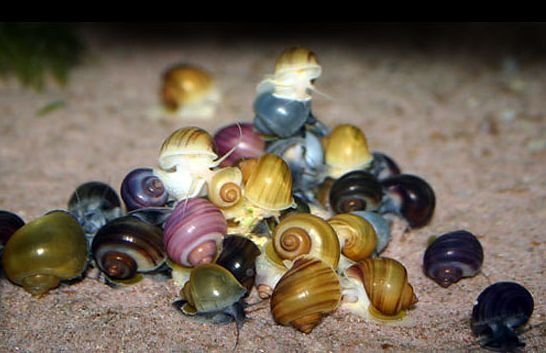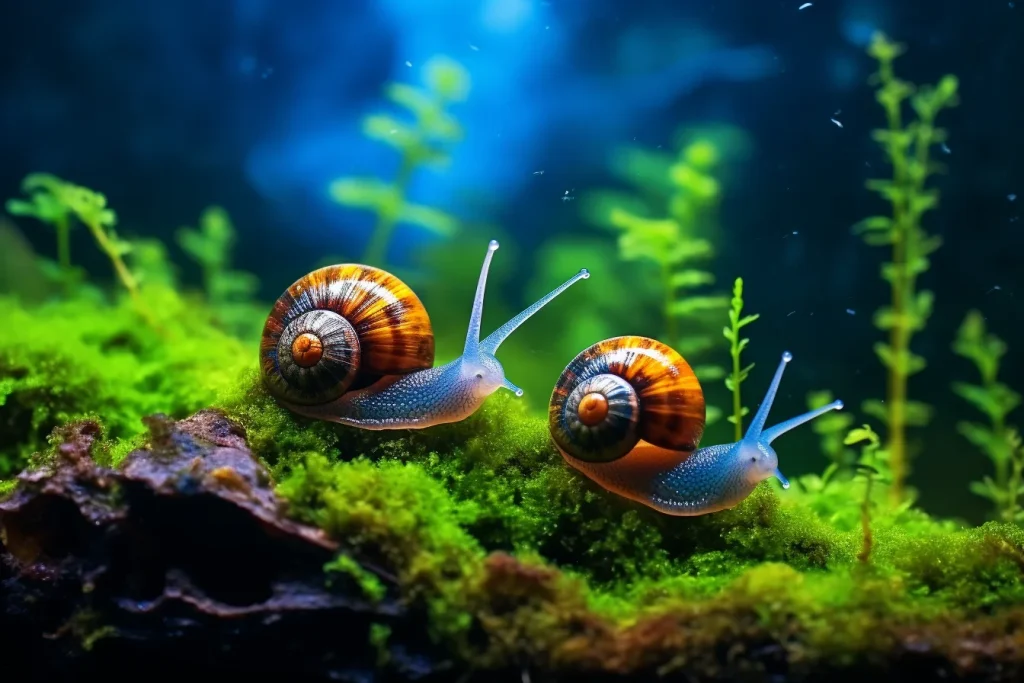As appealing scavengers, mystery snails (Pomacea diffusa) frequently sneak into home aquariums as hitchhikers on plants and decor. Their prolifically reproductive nature soon floods tanks with offspring requiring population control intervention. By understanding mystery snail breeding dynamics and leveraging key environmental variables, aquarists can halt excessive breeding and balance aquarium ecosystems.
This guide details targeted methods to prevent mystery snail mating behaviors and limit reproductive success when overpopulation issues emerge. With a strategic management approach, aquarists can selectively curb mystery snail breeding while still benefiting from their algae grazing services.
The Rapid Reproductive Capabilities of Mystery Snails
To develop effective control strategies, aquarists must first understand the prolific breeding potential of mystery snails before numbers spiral out of control:
- Sexual maturity: Mystery snails reach reproductive age rapidly, becoming capable of breeding at just 2-3 months old at 1 inch diameters.
- Mating frequency: During active periods, mystery snails may copulate every 1-2 weeks, with each mating bout capable of fertilizing 100+ eggs.
- Egg-laying capacity: A single adult mystery snail individual can deposit 20-50 pinkish egg clutches monthly containing 5-40 eggs each under optimal conditions.
- Offspring viability: Fertilized mystery snail eggs boast an 85%+ hatch rate in just 2-3 weeks when given adequate moisture, humidity and warmth.
This combination of early sexual maturity, frequent mating habits, high individual fecundity and extreme offspring viability primes mystery snail populations to explode exponentially when left unchecked.
So controlling reproduction rates becomes imperative to prevent mystery snails from rapidly overrunning aquariums once established.
Key Breeding Triggers to Restrict
Mystery snails require certain environmental cues before initiating energy-intensive mating and laying behaviors. By manipulating associated husbandry factors, aquarists can dissuade reproduction:
- Space for egg deposition: Mystery snails prefer laying clutches above the waterline on hard surfaces like tank walls and decor. Remove clutch sites by covering vertical surfaces and raising water levels to deter breeding instincts.
- Stable warm temperatures: Maintain tank temperatures between 72-86°F to encourage mystery snail activity and breeding. Lower temperatures below 72°F to reduce mating urges.
- Adequate food sources: Keep mystery snail diet varied but controlled. Overfeeding fuels mating behaviors. Restrict feeds to limit energy available for reproduction.
- Presence of opposite sexes: Mystery snails are not self-fertile hermaphrodites, requiring male and female pairs to breed successfully. Isolate sexes into separate tanks when possible.
Limiting these key environmental reproductive triggers restricts opportunities for mating and egg clutches. But additional targeted methods also help control population sizes.
Active Reduction Methods
Alongside restricting breeding conditions, aquarists can take more direct measures to limit baby mystery snail yields:
- Remove egg clutches: Inspect above-water hardscapes routinely for pinkish gelatinous egg masses. Scrape off all detected clutches before they hatch to restrict offspring numbers.
- Isolate egg clutches: Alternatively, let clutches hatch out in isolated nursery containers filled with tank water. Cull mercifully once hatched.
- Manually cull excess: As a last resort, humanely euthanize excess adult mystery snails via crushing or freezing methods to reduce breeding population size.
When snail numbers already appear unsustainable, manually reducing their ranks or limiting hatchlings proves necessary alongside preventative measures for rebounds.
Balancing Mystery Snail Populations Long Term
Once mystery snail reproduction slows following initial population booms, aquarists can maintain balance easier long term through diligent management:
- Sustain conditions discouraging breeding activity, including cooler temperatures, lower feeding rates and ample surface area to disperse breeding.
- Let small numbers of mystery snails thrive to retain their beneficial algae grazing effects. But continue manually removing the majority of egg clutches laid to restrict hatchling yields.
- Slowly remove excess adult mystery snails over time through natural attrition without replacing them. This gently brings populations down without shocking aquatic ecosystems.
With close observation and moderate culling efforts, aquarists can stabilize post-boom mystery snail populations for sustainable balance alongside other inhabitants.
Conclusion: Proactively Managing Mystery Snail Breeding
Through a bit of planning and proactive management, aquarists can fully control seemingly uncontrolled mystery snail reproduction even in established tanks. Combining targeted conditioning methods alongside manual reduction techniques prevents their prolific breeding nature from overrunning aquarium environments once introduced.
While mystery snail breeding cannot be fully stopped under optimal conditions, aquarists can strike a sustainable balance between curbing reproduction and retaining their helpful algae grazing benefits. Avoid reactionary shock treatment measures by instead restricting breeding triggers and manually thinning ranks before they overwhelm available space. With a thoughtful strategy, mystery snails can thrive moderately without pushing ecosystems past carrying capacity through excessive breeding.
The key lies in monitoring reproduction warning signs closely rather than allowing exponential population booms requiring aggressive intervention. So be proactive, leverage key environmental controls, manually remove egg clutches and occasionally thin mature populations. With moderate diligent effort, mystery snail breeding can be effectively limited as needed to balance aquarium ecosystems.
FAQ
Q1: How to stop mystery snails from breeding in my aquarium?
A1: To stop mystery snails from breeding, you can separate males and females, adjust the water temperature to discourage breeding, and promptly remove any egg clutches.
Q2: Are mystery snails asexual?
A2: No, mystery snails are not asexual. They require both male and female for reproduction. Understanding their sexual reproduction process is key to controlling breeding.
Q3: How often do mystery snails lay eggs?
A3: Mystery snails lay eggs every few weeks under suitable conditions. Monitoring your tank for egg clutches and removing them can prevent unwanted snail populations.
Q4: How do you breed snails?
A4: To breed snails, you need to provide a conducive environment with the right temperature and food. However, if you wish to prevent breeding in mystery snails, these conditions should be carefully managed.
Q5: What to feed nerite snails?
A5: Nerite snails thrive on a diet of algae and blanched vegetables. Proper feeding ensures their health without necessarily promoting breeding.
Q6: Mystery snail sexes – how to identify them for controlling breeding?
A6: Identifying mystery snail sexes can be challenging. Females are generally larger and have a rounded shell opening compared to males. Separating them by sex can help control breeding.
Q7: Mystery snails breeding – what are the signs and how to manage it?
A7: Signs of mystery snails breeding include the male mounting the female and the female laying eggs above the water line. Managing water conditions and population can help control breeding.



